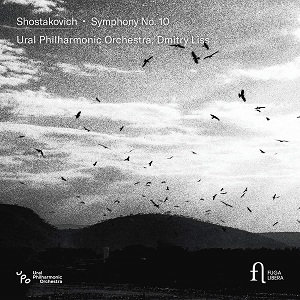
Dmitri Shostakovich (1906-1975)
Symphony No 10 in E minor, Op 93 (1953)
Ural Philharmonic Orchestra/Dmitry Liss
rec. live, November 2021, Sverdlovsk Philharmonic Hall, Yekaterinburg, Russia
Fuga Libera FUG809 [51]
Shostakovich’s Tenth Symphony is perhaps the composer’s greatest masterpiece in the symphonic genre; many consider this work as one of the first to begin the ‘thaw’ in Soviet life after the death of Stalin. It was also a period when the world was involved in a battle between two great powers, and the danger of nuclear war was ever-present. Unlike several of Shostakovich’s previous works, the Tenth was quickly performed successfully in the West, notably by Ormandy and Mitropoulos.
Yet securing a performance of the Tenth in Leningrad was problematic; Mravinsky had to argue with Ponomarenko, the Minister of Culture, that it was worthy of a premiere and offered no fewer than ten reasons why the work was a new masterpiece in the Russian symphonic repertoire and the minister gave permission for premieres in both Leningrad and Moscow – a sign that things were changing in Russian cultural life.
Of the many recordings of this great work, Mravinsky’s recordings offer the most authentic interpretations with magnificent performances by the Leningrad Philharmonic Orchestra in mono and stereo versions. Other fine recordings are those by Ančerl, Kondrashin, Haitink, Ormandy, Mitropoulos, Previn and Karajan. This is the second recording of this work by Russian conductor Dmitry Liss, who considers the Tenth to be one of the composer’s most important works; the first was with the Philharmonie Zuidnederland Orchestra, also on the Fuga Libera label and issued in 2019 coupled with Olga Victorova’s ‘Quinlong Azur Dragon’.
I have not heard that first recording but was very impressed by his recently issued recordings of Prokofiev’s Second Piano Concerto and the Second Symphony – both intensely complex scores which demand the highest technical and interpretative skills. The Ural Philharmonic Orchestra is a highly talented ensemble with fine soloists in the woodwind and brass groups and outstanding strings.
This Tenth was recorded at a concert in November 2021 in the Sverdlovsk Philharmonic Hall – a venue which boasts a fine acoustic in an archetypal shoebox concert hall built in the 1930s.
In the opening Moderato, the strings introduce a darkly atmospheric, ominous passage before the hopeful yet isolated phrasing from the clarinet of Yuri Nechayev allows a break in the tension. As the opening theme develops, the flutes accompanied by the strings invoke a waltz-like sequence of play heralding virtuosic intonation from Alexander Kudinov on the oboe, and the bassoon of Andrey Postoyev in citing ‘What is My Name?’ from the composer’s collection of songs based on Pushkin. Liss masterly handles the palpable shifts in tempo and mood, creating a threatening mood in one of Shostakovich’s most prolonged movements, before the piccolo flutes of Mari Markul and Zhanna Lopatina offer hope and enlightenment at the end. The fiercely dynamic Allegro is superbly directed by the conductor who conjures tremendous playing from the orchestra. Rather than portraying Stalin here, it always seems to me that it rather presents a scene of warfare contested by terrible opponents.
The third movement, Allegretto is, for me, the emotional heart of the symphony, with the strings announcing the monogram of the composer D-Es-C-H in a passage leading to a powerfully explosive moment broken only by the French horn of Rudolf Pochtaryov intoning the motif E-La-Mi-Re-A, supposedly representing the composer’s lover Elmira Nazirova – although Mravinsky thought it portrayed himself. Rather than speculate, perhaps it is best that this remains a riddle. The mysterious horn call repeated twelve times creates a mood of suspicion and uncertainty as the two motifs become ever closer.
In the Finale: Andante, Liss masterly segues from the slow beginning into the more dynamic pace of Allegro, and again the D-Es-C-H motif is heard on the woodwind, creating a passage of great suspense – I was impressed by the concentration of the strings’ playing and in the conductor’s fervent reading of this symphony. The coda makes the transition to E major, and slowly the tragic culmination unfolds glissando in the final chords on the strings. The musicologist Leonid Gaakel who attended the premiere writes: ‘the symphony told its audience that night that the feeling of personal freedom is the summit of human existence, however difficult the ascent.’ No applause is included.
The recording is excellent and captures the excitement of a live concert. There is no suggestion of an audience being present or affecting one’s enjoyment of this outstanding performance by a top-class Russian orchestra. There are innumerable modern recordings of this symphony, notably by Gergiev, Nelsons, Petrenko, and Noseda, which are terrific in terms of both recording and interpretation; however, this new CD has that bare-knuckle thrill of a live event in which the listener shares in a great and moving experience. The CD is in a folded cardboard envelope with colour photographs of the orchestra and conductor and an 18-page booklet with notes by Yelena Krivonogova in Russian translated into English, and French. The text uses Volkhov’s largely discredited book ‘Testimony’ in appraising the symphony.
Gregor Tassie
Help us financially by purchasing from





















